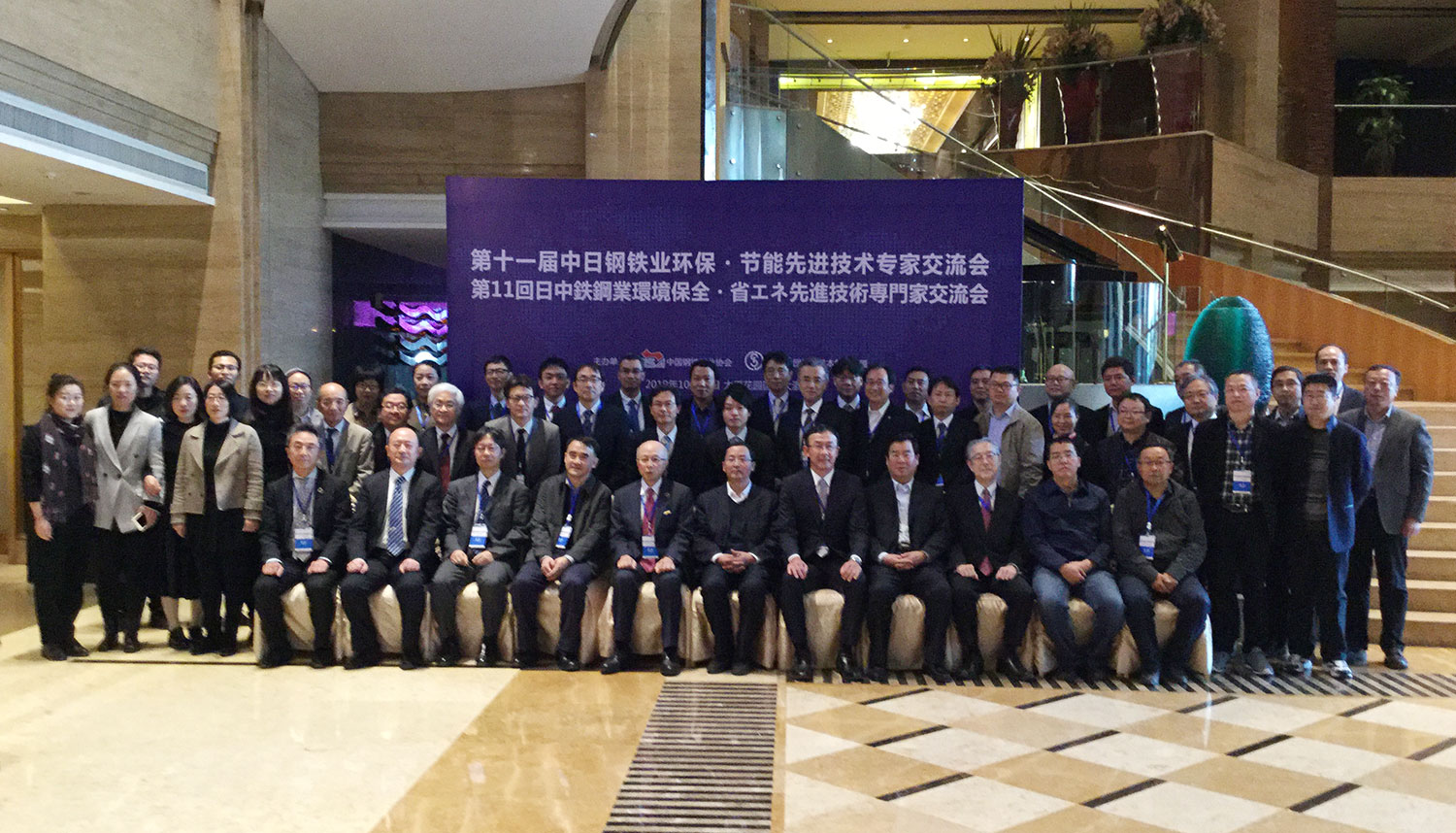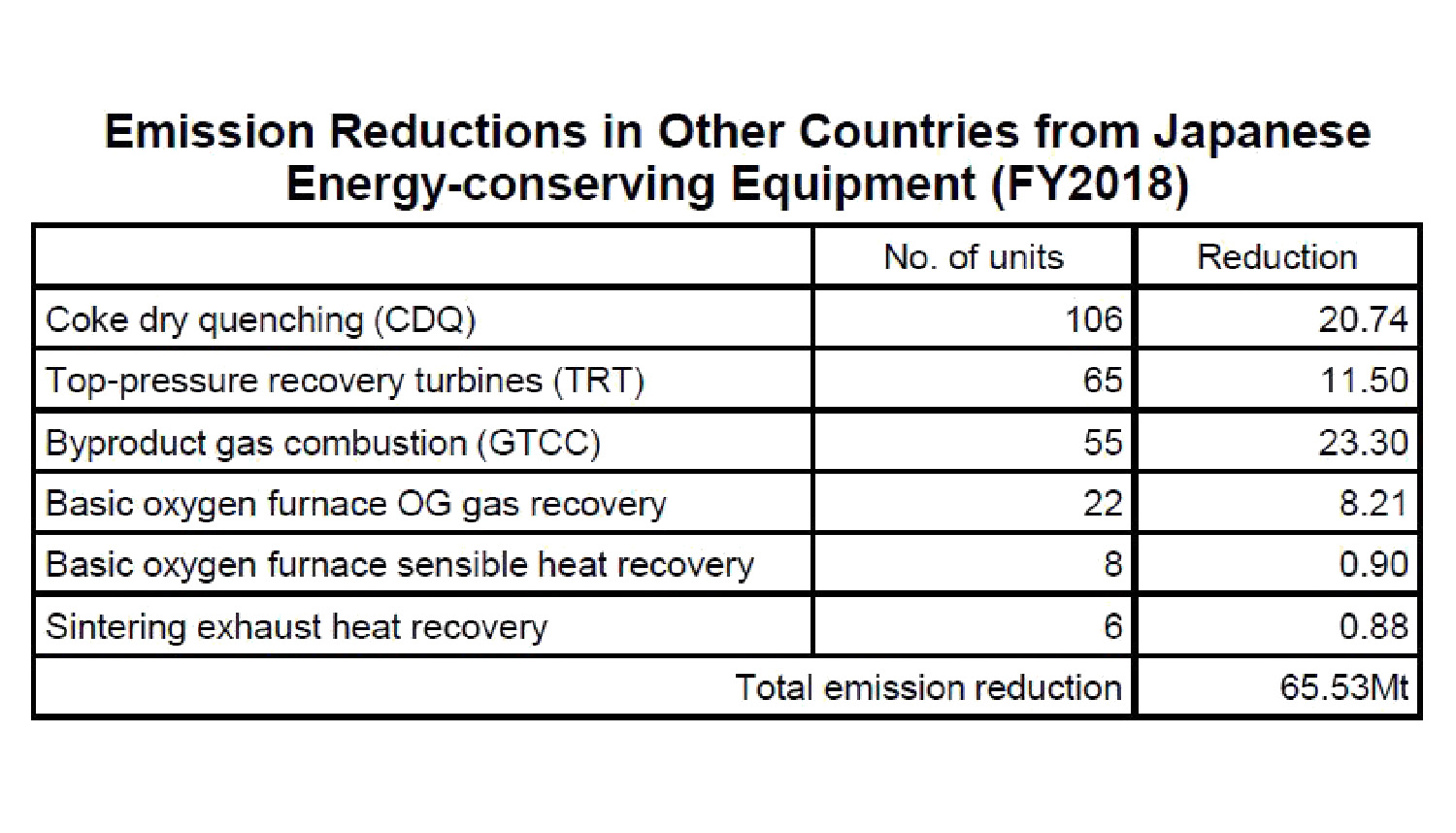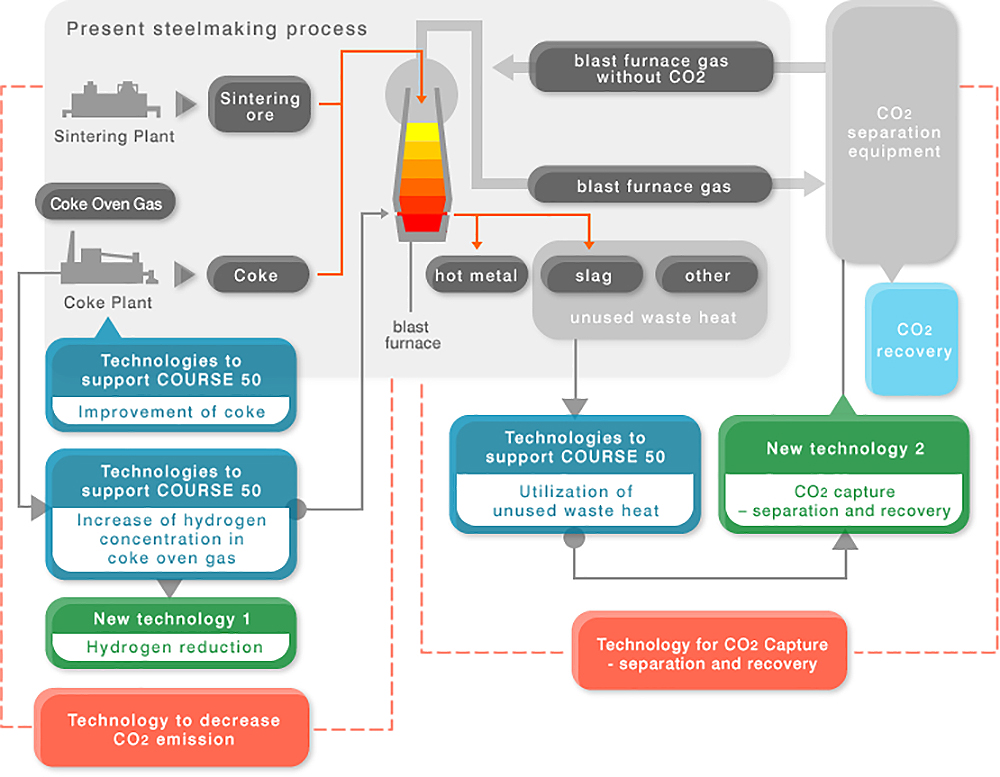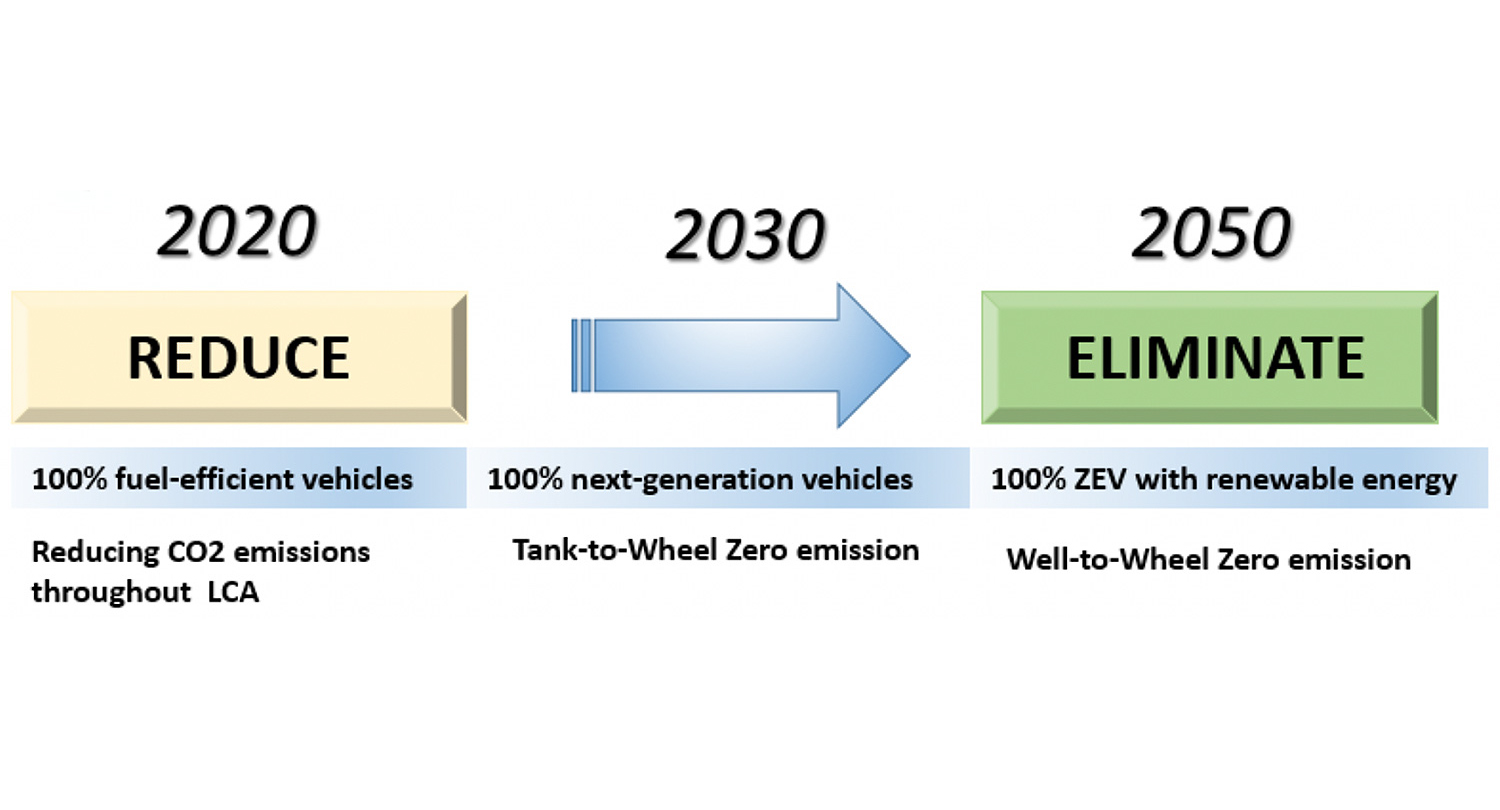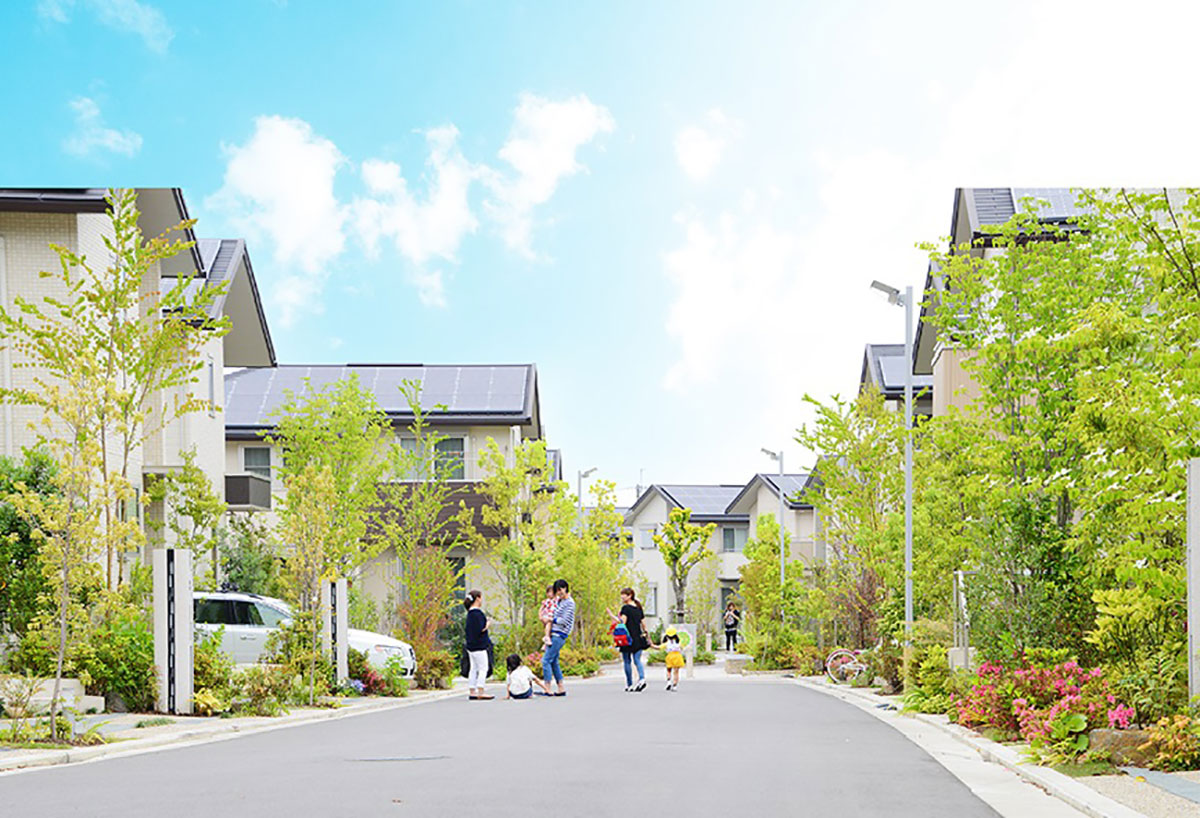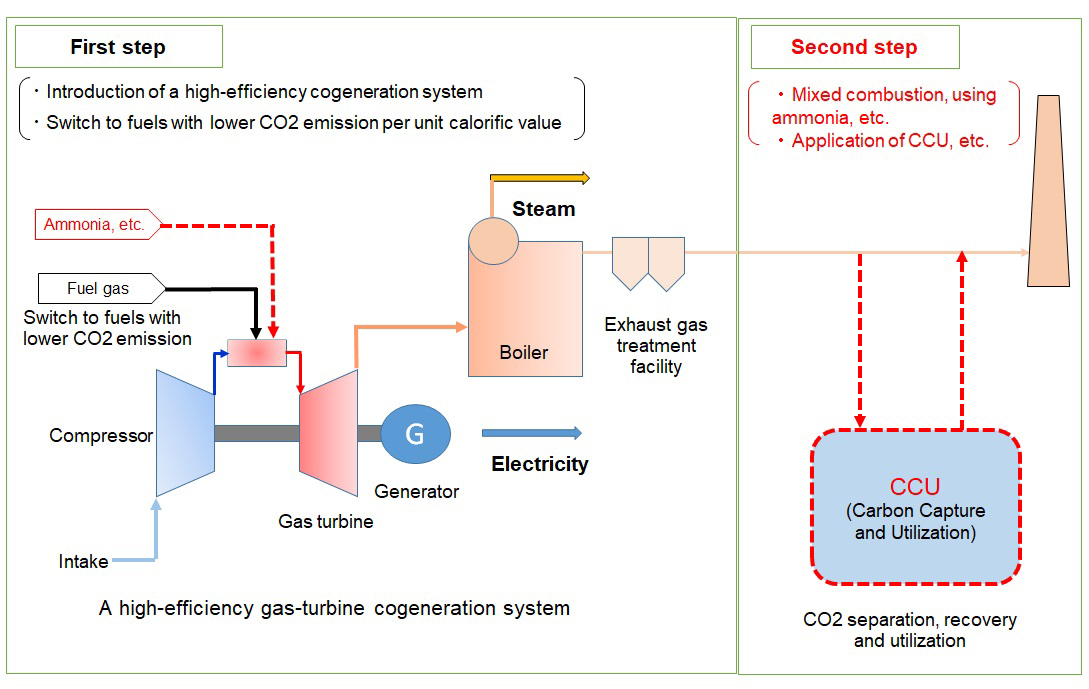Promoting global-scale measures to combat global warming through overseas transfer and spread of energy conservation technologies
The Japan Iron and Steel Federation
Outline
Under the action plan called “Commitment to a Low Carbon Society,” the participating companies of the Japan Iron and Steel Federation (JISF) are working as one to maintain and improve the Japanese steel industry’s energy efficiency, which is at the highest level in the world. The JISF member companies are also promoting global-scale measures to combat global warming by transferring and disseminating energy conservation and environmental technologies that have been developed and put into practical use in Japan to developing countries and spreading such technologies there.
Global crude steel production currently stands at about 1.9 billion tons. The amount of steel stock per capita in advanced countries is about 8 to 12 tons (10.7 tons in Japan), while the global average per capita is only about 4 tons. If many countries and regions are to achieve development on a par with advanced countries in the future, the per-capita amount of steel stock will need to increase. It is also certain that steel production through natural resource routes will expand on a global scale.
When steel plants will be newly constructed in emerging steel countries, if energy conservation technologies that have been developed and put into practical use in Japan are equipped as standard equipment, it can reduce CO2 emissions by tens million tons every year. The operations of Eco-Solution is an extremely effective measures to combat global warming, as with technological development.
Description
Under the action plan called “Commitment to a Low Carbon Society,” the participating companies of the Japan Iron and Steel Federation (JISF) are working as one to maintain and improve the Japanese steel industry’s energy efficiency, which is at the highest level in the world. The JISF member companies are also promoting global-scale measures to combat global warming by transferring and disseminating energy conservation and environmental technologies that have been developed and put into practical use in Japan to developing countries and spreading such technologies there.
Global crude steel production currently stands at about 1.9 billion tons. The amount of steel stock per capita in advanced countries is about 8 to 12 tons (10.7 tons in Japan), while the global average per capita is only about 4 tons. If many countries and regions are to achieve development on a par with advanced countries in the future, the per-capita amount of steel stock will need to increase. It is also certain that steel production through natural resource routes will expand on a global scale.
Under these circumstances, to promote measures to combat global warming, it is extremely effective to improve the steel industry’s energy efficiency on a global scale. In addition to developing super innovative technologies such as hydrogen reduction, until the time when such technologies are put into practical use, facilities currently in operation1 and new facilities to be constructed or added in a short or medium period of time2 should be installed with the best available technologies (BATs) that are already in practical use.3
The JISF has held the Japan–China Steel Industry Environmental Protection and Energy Conservation Technology Conference (since 2005) with China, the Public and Private Collaborative Meeting between Indian and Japanese Iron and Steel Industry (since 2011) with India, and the ASEAN–Japan Steel Initiative (since 2014) with ASEAN countries. Through these and other bilateral and multilateral cooperative activities, the JISF has, for example, introduced the Japanese steel industry’s technologies and efforts for energy conservation and offered energy conservation-related policy proposals to the governments of these partner countries.
As for cooperation with India and ASEAN countries, the JISF has evaluated energy conservation measures at 26 steel plants in 7 countries on the basis of the ISO 14404 international standard for calculating method of CO2 emission intensity from iron and steel production.4 (Japan played a leading role in developing this standard.) Furthermore, on the basis of evaluation results, discussions were held between experts in Japan and engineers in these countries and regions, and technologies suitable for each of the countries and regions were listed in the Technologies Customized List (for India or ASEAN). The list has been shared at meetings and workshops between the public sector and the private sector.
Furthermore, as part of the above-mentioned efforts, the achievements of the ASEAN–Japan Steel Initiative, including people-to-people interactions and recommended technological proposals, are being used for the project to find Joint Crediting Mechanism (JCM) projects in Thailand, the Philippines, and Indonesia, which started in fiscal 2019.
Meanwhile, the major energy conservation technologies developed and put into practical use in the Japanese steel industry have been introduced in China, South Korea, India, Russia, Ukraine, Brazil, and other foreign countries, and the CO2 reduction effects of these technologies amounted to a total of 65.53 million tons per year as of fiscal 2018. (This amount is equivalent to about 30% of CO2 emitted in the Japanese steel industry.)
On the other hand, the following challenges have been identified. When steelmakers in developing and emerging countries introduce new facilities, they tend to prioritize initial investment or running cost over performance. As a result, there are actual cases in which steelmakers fail to maximize the energy conservation effects of the new facilities introduced due to mechanical troubles, etc. To improve energy conservation effectiveness, it is important to choose facilities from comprehensive viewpoints, including not only performance but also operating ratio and maintenance cost. To increase the effectiveness of Eco-Solution activities, the JISF has also begun rulemaking for evaluation methods and guidelines that can help promote energy conservation more efficiently.
As mentioned above, it is expected that in developing and emerging countries, new steel production facilities will continue to be constructed or added, and steel production will increase further. The JISF will strongly promote these Eco-Solution activities and continue to take up the challenge of reducing CO2 emissions in the world by 100 million tons every year.
1. In China and India, where steel production has increased rapidly in the present century, investments have been made for blast furnaces with total production capacities equivalent to about 200 million tons of crude steel (about 160 million tons in China and about 40 million tons in India) since 2010. The standard investment recovery period for blast furnaces is more than 50 years, including brick relining every 15 to 20 years. Therefore, these facilities will continue to operate for the next several decades.
2. Under the National Steel Policy, the Indian government aims to expand the nation’s steel production capacity to 300 million tons (180 million to 195 million tons at blast furnaces) by 2030. In addition, as for investments made by the Chinese steel industry for overseas business operations, facilities with capacities equivalent to about 8 million tons of crude steel (about 7.9 million tons in ASEAN countries) were in operation as of January 2019, and there are plans for facilities with capacities of about 75 million tons (about 50 million tons in ASEAN countries and 23 million tons in South America).
3. The best available technologies (BATs) mentioned here are technologies for efficient use of byproduct gases emitted in ironmaking processes and waste heat recovery technologies that use coke dry quenching (CDQ) systems, top-pressure recovery turbines (TRTs), etc. According to the Research Institute of Innovative Technology for the Earth (RITE), a public interest incorporated foundation, there is still a large potential for using byproduct gases efficiently and introducing CDQ systems, TRTs, and other facilities in countries other than Japan. This shows that existing facilities constructed relatively recently or new facilities to be constructed are expected to achieve major emission reductions by installing the BATs.
Reference: Research Institute of Innovative Technology for the Earth, 2015 nen jiten no enerugi gentani no suitei (tekko bumon, tenroko) [Estimate of energy consumption intensity as of 2015 (steel sector, converter steel)], http://www.rite.or.jp/system/global-warming-ouyou/download-data/EnergyEfficiency2015.pdf.
4. The ISO 14404 standard provides methods for calculating the amount of energy consumption, the amount of energy consumption intensity, the amount of CO2 emissions, and the amount of CO2 emission intensity by using only a steel plant’s normal operational data, such as the amount of crude steel production and the amount of energy purchased and sold, within a boundary that is set to be the whole of the steel plant. Japan played a leading role in developing the standard. The standard currently consists of Part 1 (Steel Plant with Blast Furnace), Part 2 (Steel Plant with Electric Arc Furnace (EAF)), and Part 3 (Steel Plant with Electric Arc Furnace (EAF) and Coal-Based or Gas-Based Direct Reduction Iron (DRI) Facility). A guidance standard for ISO 14404 is currently under development for steel plants with a complex composition of facilities.
Partner(s)
The list of participating companies to Commitment to a Low Carbon Society
https://www.meti.go.jp/shingikai/sankoshin/sangyo_gijutsu/chikyu_kankyo/tekko_wg/pdf/2019_001_04_03.pdf
Supplementary information
Commitment to a Low Carbon Society in the Japan Iron and Steel Federation
https://www.jisf.or.jp/business/ondanka/kouken/keikaku/
Other Innovation Challenges
Realizing “Zero-Carbon Steel” through Hydrogen Reduction Iron-making Technology
The Japan Iron and Steel Federation
Similar Innovation Challenges
Achieve 2050 decarbonization target with Net Zero Energy House!
Sekisui House, Ltd.
Achieving net-zero emissions by promoting renewable energy use through both our monozukuri and products.
DAIWA HOUSE INDUSTRY CO., LTD.



